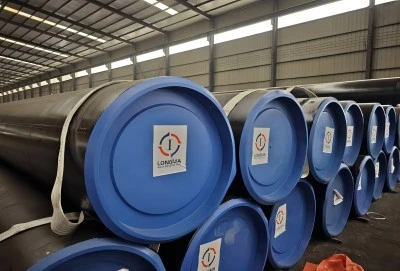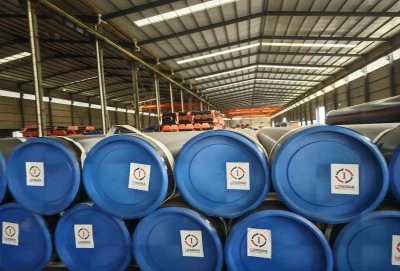In the realm of oil and gas transportation, the performance of pipeline materials in extreme environments is crucial for ensuring safety, efficiency, and longevity of operations. One material that has gained significant attention for its robustness in challenging conditions is the API 5L X52 PSL2 steel pipe. This blog post delves into the application performance of this pipe grade in extreme cold environments, exploring its mechanical properties, toughness variations, and best installation practices.
|
|
|
What are the mechanical properties of API 5L X52 PSL2 steel pipe in sub-zero temperatures?
The API 5L X52 PSL2 steel pipe is renowned for its exceptional mechanical properties, which are particularly crucial when operating in sub-zero temperatures. Let's examine how these properties hold up in extreme cold conditions:
1. Yield Strength: The yield strength of API 5L X52 PSL2 steel pipe is typically around 52,000 psi (358 MPa) at room temperature. In sub-zero temperatures, this strength tends to increase slightly due to the phenomenon known as low-temperature strengthening. This increase in yield strength can be beneficial in resisting deformation under high pressures in cold environments.
2. Tensile Strength: Similar to yield strength, the tensile strength of X52 steel also experiences a slight increase in extremely cold conditions. This enhanced tensile strength contributes to the pipe's ability to withstand higher stresses without failure.
3. Elongation: While strength increases, the elongation (ductility) of the steel may decrease slightly at very low temperatures. However, the API 5L X52 PSL2 grade is designed to maintain adequate ductility even in cold conditions, ensuring that the pipe can still absorb energy and resist brittle fracture.
4. Young's Modulus: The elastic modulus of steel tends to increase marginally at low temperatures, making the material slightly stiffer. This can affect the pipe's response to dynamic loads and thermal stresses.
5. Thermal Expansion Coefficient: In extreme cold, the thermal expansion coefficient of the steel decreases, which can be advantageous in reducing thermal stresses caused by temperature fluctuations.
6. Hardness: The hardness of X52 steel may increase slightly in sub-zero temperatures, which can contribute to improved wear resistance but may also slightly increase the risk of brittle behavior if not properly managed.
It's important to note that while these changes in mechanical properties occur, the API 5L X52 PSL2 steel pipe is designed to maintain its overall integrity and performance within the specified operating temperature range. The slight alterations in properties are typically accounted for in the design and operation parameters of pipelines intended for cold environments.
How does the toughness of API 5L X52 PSL2 steel pipe vary in extreme cold conditions?
Toughness is a critical property for pipeline materials, especially in extreme cold conditions where the risk of brittle fracture increases. The API 5L X52 PSL2 steel pipe is engineered to maintain adequate toughness even at low temperatures, but it's essential to understand how this property varies:
1. Charpy V-Notch (CVN) Impact Energy: The CVN test is a standard method for assessing the toughness of steel. For API 5L X52 PSL2, the impact energy typically decreases as the temperature drops. However, the rate of decrease is designed to be gradual, ensuring that the material retains sufficient toughness even at the lower end of its operating temperature range.
2. Ductile-to-Brittle Transition Temperature (DBTT): This is the temperature at which the steel's fracture mode changes from ductile to brittle. For X52 PSL2 grade, the DBTT is engineered to be well below the minimum operating temperature, ensuring that the pipe remains in the ductile regime during normal operations.
3. Fracture Toughness: The fracture toughness, which quantifies the material's resistance to crack propagation, generally decreases with temperature. However, the X52 PSL2 grade is designed to maintain acceptable fracture toughness values even in extreme cold, reducing the risk of rapid crack propagation.
4. Low Temperature Toughness Requirements: The PSL2 designation of the API 5L X52 pipe indicates more stringent toughness requirements compared to PSL1. This includes specific CVN energy absorption criteria at low temperatures, typically tested at temperatures as low as -40°C or even lower for arctic applications.
5. Microstructure Stability: The fine-grained microstructure of X52 PSL2 steel contributes to its low-temperature toughness. This microstructure remains relatively stable even at very low temperatures, helping to maintain the pipe's toughness properties.
6. Alloying Elements: The specific alloying elements used in X52 PSL2 steel, such as nickel and molybdenum, contribute to its low-temperature toughness. These elements help to lower the DBTT and improve the steel's performance in cold environments.
7. Weld Zone Toughness: Special attention is given to the toughness of weld zones in API 5L X52 PSL2 pipes. These areas are often the most vulnerable to low-temperature embrittlement, so welding procedures are carefully controlled to ensure adequate toughness in these critical regions.
Understanding these toughness variations is crucial for engineers and operators working with API 5L X52 PSL2 pipes in extreme cold environments. While the material is designed to perform well in such conditions, it's essential to consider these variations when designing, installing, and operating pipelines in arctic or sub-arctic regions.
What are the best practices for installing API 5L X52 PSL2 pipelines?
Installing API 5L X52 PSL2 pipelines in extreme cold environments requires careful planning and execution to ensure the long-term integrity and performance of the system. Here are some best practices to consider:
1. Temperature Management:
- Monitor and control the temperature of the pipe during transportation, storage, and installation.
- Avoid sudden temperature changes that could induce thermal stresses. - Use thermal blankets or heating systems when necessary to maintain workable temperatures.
2. Welding Procedures:
- Develop and qualify specific welding procedures for low-temperature conditions.
- Use low-hydrogen welding consumables to reduce the risk of hydrogen-induced cracking.
- Implement proper preheating and post-weld heat treatment as required by the welding procedure specification.
3. Material Handling:
- Use appropriate lifting and handling equipment designed for cold weather operations.
- Avoid impact loading or rough handling that could induce stress concentrations or damage the pipe coating.
4. Trench Preparation:
- Ensure proper trench preparation, including adequate bedding and backfill materials that won't freeze to the pipe.
- Consider the effects of frost heave and implement appropriate mitigation measures.
5. Coating and Corrosion Protection:
- Select coating systems specifically designed for low-temperature applications.
- Apply coatings under controlled conditions, adhering to manufacturer specifications for temperature and humidity. - Implement cathodic protection systems designed for cold soil conditions.
6. Stress Analysis:
- Conduct comprehensive stress analysis considering thermal expansion/contraction, soil movement, and other environmental factors.
- Design expansion loops or other stress-relief features as necessary.
7. Quality Control:
- Implement rigorous quality control measures, including non-destructive testing (NDT) of welds.
- Conduct hydrostatic testing under controlled conditions, considering the effects of low temperatures on test parameters.
8. Environmental Considerations:
- Adhere to all environmental regulations and best practices for working in sensitive cold environments.
- Implement erosion control measures to protect the pipeline route during and after installation.
9. Safety Protocols:
- Develop and implement comprehensive safety protocols for working in extreme cold conditions.
- Provide appropriate personal protective equipment (PPE) for workers.
10. Monitoring and Maintenance: - Install appropriate monitoring systems to track pipeline performance and detect any issues early.
- Develop a comprehensive maintenance plan that accounts for the challenges of accessing and maintaining the pipeline in extreme cold conditions.
11. Training:
- Ensure all personnel involved in the installation are properly trained in cold weather operations and familiar with the specific challenges of working with API 5L X52 PSL2 pipes in extreme environments.
12. Documentation:
- Maintain detailed records of all installation procedures, including environmental conditions, welding parameters, and quality control results.
13. Permafrost Considerations:
- In areas with permafrost, implement special design and installation techniques to minimize heat transfer from the pipeline to the surrounding soil.
- Consider using insulation or above-ground installation where appropriate to prevent permafrost degradation.
14. Seasonal Planning:
- Plan installation activities to take advantage of the most favorable weather conditions when possible.
- Develop contingency plans for dealing with unexpected weather events or extended periods of extreme cold.
15. Pipe Joining Techniques:
- Consider alternative joining methods such as mechanical connectors or automated welding systems that may be more suitable for extreme cold conditions.
By adhering to these best practices, installers can maximize the performance and longevity of API 5L X52 PSL2 pipelines in extreme cold environments. It's crucial to remember that each installation project may have unique challenges, and a thorough site-specific assessment should always be conducted to tailor these practices to the particular conditions of the project.
Longma Group
The application of API 5L X52 PSL2 steel pipes in extreme cold environments demonstrates the remarkable engineering behind modern pipeline systems. By understanding the material's behavior at low temperatures and implementing proper installation practices, operators can ensure safe and efficient transportation of oil and gas even in the most challenging Arctic conditions. As the demand for energy resources continues to push exploration and production into colder regions, the importance of materials like API 5L X52 PSL2 steel pipe cannot be overstated. Their ability to maintain crucial mechanical properties and toughness in sub-zero temperatures makes them an indispensable component of cold-climate energy infrastructure. For those involved in pipeline projects in extreme cold environments, it's essential to stay informed about the latest developments in materials science and installation techniques. By combining cutting-edge materials with best practices in installation and maintenance, we can continue to push the boundaries of what's possible in pipeline engineering, ensuring safe and reliable energy transportation in even the most unforgiving climates.
If you're looking for high-quality API 5L X52 PSL2 Pipes for your extreme cold environment applications, look no further than Longma Group. Our expertly engineered pipes are designed to withstand the harshest conditions while maintaining optimal performance. Contact us today at info@longma-group.com to discuss your project requirements and how we can provide the perfect solution for your pipeline needs.














